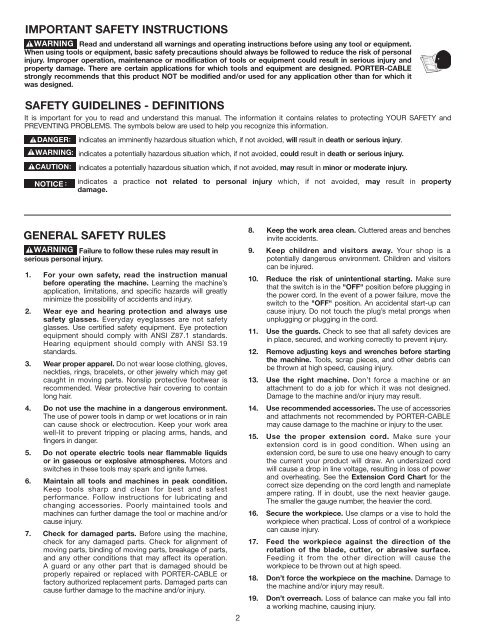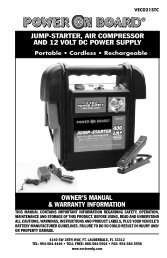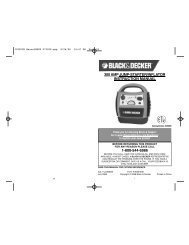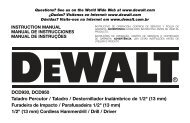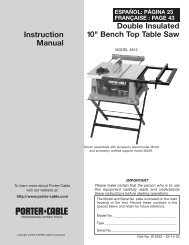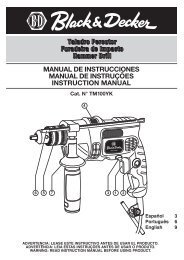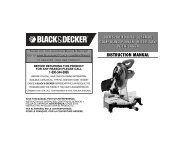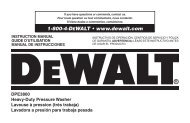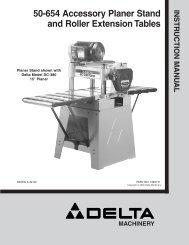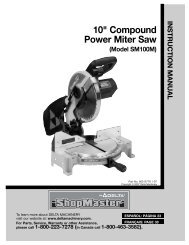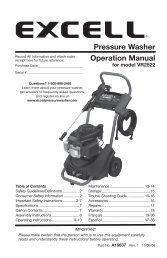Cepillo Portátil de 317 mm
Cepillo Portátil de 317 mm
Cepillo Portátil de 317 mm
You also want an ePaper? Increase the reach of your titles
YUMPU automatically turns print PDFs into web optimized ePapers that Google loves.
IMPORTANT SAFETY INSTRUCTIONS<br />
Read and un<strong>de</strong>rstand all warnings and operating instructions before using any tool or equipment.<br />
When using tools or equipment, basic safety precautions should always be followed to reduce the risk of personal<br />
injury. Improper operation, maintenance or modification of tools or equipment could result in serious injury and<br />
property damage. There are certain applications for which tools and equipment are <strong>de</strong>signed. PORTER-CABLE<br />
strongly reco<strong>mm</strong>ends that this product NOT be modified and/or used for any application other than for which it<br />
was <strong>de</strong>signed.<br />
SAFETY gUIdELINES - dEFINITIONS<br />
It is important for you to read and un<strong>de</strong>rstand this manual. The information it contains relates to protecting YOUR SAFETY and<br />
PREVENTING PROBLEMS. The symbols below are used to help you recognize this information.<br />
NOTICE<br />
AVIS<br />
AVISO<br />
indicates an i<strong>mm</strong>inently hazardous situation which, if not avoi<strong>de</strong>d, will result in <strong>de</strong>ath or serious injury.<br />
indicates a potentially hazardous situation which, if not avoi<strong>de</strong>d, could result in <strong>de</strong>ath or serious injury.<br />
indicates a potentially haz ard ous situation which, if not avoi<strong>de</strong>d, may result in minor or mod er ate injury.<br />
indicates a practice not related to personal injury which, if not avoi<strong>de</strong>d, may result in property<br />
damage.<br />
gENERAL SAFETY RULES<br />
Failure to follow these rules may result in<br />
serious personal injury.<br />
1. For your own safety, read the instruction manual<br />
before operating the machine. Learning the machine’s<br />
application, limitations, and specific hazards will greatly<br />
minimize the possibility of acci<strong>de</strong>nts and injury.<br />
2. Wear eye and hearing protection and always use<br />
safety glasses. Everyday eyeglasses are not safety<br />
glasses. Use certified safety equipment. Eye protection<br />
equipment should comply with ANSI Z87.1 standards.<br />
Hearing equipment should comply with ANSI S3.19<br />
standards.<br />
3. Wear proper apparel. Do not wear loose clothing, gloves,<br />
neckties, rings, bracelets, or other jewelry which may get<br />
caught in moving parts. Nonslip protective footwear is<br />
reco<strong>mm</strong>en<strong>de</strong>d. Wear protective hair covering to contain<br />
long hair.<br />
4. do not use the machine in a dangerous environment.<br />
The use of power tools in damp or wet locations or in rain<br />
can cause shock or electrocution. Keep your work area<br />
well-lit to prevent tripping or placing arms, hands, and<br />
fingers in danger.<br />
5. do not operate electric tools near fla<strong>mm</strong>able liquids<br />
or in gaseous or explosive atmospheres. Motors and<br />
switches in these tools may spark and ignite fumes.<br />
6. Maintain all tools and machines in peak condition.<br />
Keep tools sharp and clean for best and safest<br />
performance. Follow instructions for lubricating and<br />
changing accessories. Poorly maintained tools and<br />
machines can further damage the tool or machine and/or<br />
cause injury.<br />
7. Check for damaged parts. Before using the machine,<br />
check for any damaged parts. Check for alignment of<br />
moving parts, binding of moving parts, breakage of parts,<br />
and any other conditions that may affect its operation.<br />
A guard or any other part that is damaged should be<br />
properly repaired or replaced with PORTER-CABLE or<br />
factory authorized replacement parts. Damaged parts can<br />
cause further damage to the machine and/or injury.<br />
2<br />
8. Keep the work area clean. Cluttered areas and benches<br />
invite acci<strong>de</strong>nts.<br />
9. Keep children and visitors away. Your shop is a<br />
potentially dangerous environment. Children and visitors<br />
can be injured.<br />
10. Reduce the risk of unintentional starting. Make sure<br />
that the switch is in the "OFF" position before plugging in<br />
the power cord. In the event of a power failure, move the<br />
switch to the "OFF" position. An acci<strong>de</strong>ntal start-up can<br />
cause injury. Do not touch the plug’s metal prongs when<br />
unplugging or plugging in the cord.<br />
11. Use the guards. Check to see that all safety <strong>de</strong>vices are<br />
in place, secured, and working correctly to prevent injury.<br />
12. Remove adjusting keys and wrenches before starting<br />
the machine. Tools, scrap pieces, and other <strong>de</strong>bris can<br />
be thrown at high speed, causing injury.<br />
13. Use the right machine. Don’t force a machine or an<br />
attachment to do a job for which it was not <strong>de</strong>signed.<br />
Damage to the machine and/or injury may result.<br />
14. Use reco<strong>mm</strong>en<strong>de</strong>d accessories. The use of accessories<br />
and attachments not reco<strong>mm</strong>en<strong>de</strong>d by PORTER-CABLE<br />
may cause damage to the machine or injury to the user.<br />
15. Use the proper extension cord. Make sure your<br />
extension cord is in good condition. When using an<br />
extension cord, be sure to use one heavy enough to carry<br />
the current your product will draw. An un<strong>de</strong>rsized cord<br />
will cause a drop in line voltage, resulting in loss of power<br />
and overheating. See the Extension Cord Chart for the<br />
correct size <strong>de</strong>pending on the cord length and nameplate<br />
ampere rating. If in doubt, use the next heavier gauge.<br />
The smaller the gauge number, the heavier the cord.<br />
16. Secure the workpiece. Use clamps or a vise to hold the<br />
workpiece when practical. Loss of control of a workpiece<br />
can cause injury.<br />
17. Feed the workpiece against the direction of the<br />
rotation of the bla<strong>de</strong>, cutter, or abrasive surface.<br />
Feeding it from the other direction will cause the<br />
workpiece to be thrown out at high speed.<br />
18. don’t force the workpiece on the machine. Damage to<br />
the machine and/or injury may result.<br />
19. don’t overreach. Loss of balance can make you fall into<br />
a working machine, causing injury.


